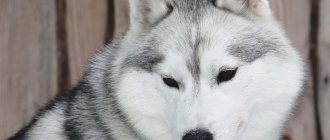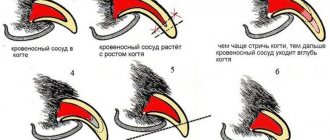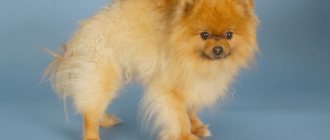The small German Spitz dog is rightly considered the most faithful companion and good friend. Medium and large species of this breed have been adapted for life in the most ordinary city apartments. The domestic German Spitz dog is fairly easy to litter train and does not require a lot of space.
A small German Spitz dog is rightly considered the most faithful companion and good friend.
What is known about the history of the breed?
According to experts, the Small German Spitz has ancestors that descended from prehistoric dog species. Their remains were once found by an archaeological group in Europe.
The first mention of an animal of this breed, the size of which was quite large, can be found in documents dating back to the 15th century. The dogs had lush curled tails and very beautiful fox faces.
According to experts, the small German Spitz has ancestors that descended from prehistoric dog species
Larger-scale work with the breed began only in the middle of the 18th century. The dog, which was quite large in size and docile in nature, was of great interest to specialists from Germany. A little later, dog breeders from America and Britain began to breed animals, wanting to breed a small breed. As a result of quite a long work, the breed has 5 species.
Nuances in the development of different subspecies
The maturation of different types of Spitz proceeds approximately the same. Regardless of the breed, the development from a baby to an adult dog takes three years. They reach their final size by about six months.
There are some features:
- One litter may produce pets of different weight, height and color.
- A miniature size that does not meet standards may indicate the presence of diseases. Harnesses and collars are not suitable for these puppies. They should not jump from heights to avoid damaging their joints.
- If your pet is larger than the accepted standards, accept it. Most often, the reason is the presence of large individuals in the pedigree. It is impossible to influence the size of a pet without harming its health.
Nature and use of the animal
It can be said that even a large Spitz is smart, friendly, intelligent and makes the best companion dog. The most vigilant white Spitz is able, if necessary, to defend its beloved owner. He is not averse to playing and running, infecting everyone around him with his fun.
The rather popular French Spitz, like the German dog, loves water and will swim with great pleasure. You need to raise a dog very affectionately, but firmly, since it is a pack animal that needs a wise leader. Even at an early age, small Spitz dogs should be weaned from barking loudly without any reason.
As you know, the large German Spitz was previously used in hunting. Today, animals are getting used to life in small apartments very well. They very quickly become attached to all family members and do not perceive loneliness well. A miniature dog neglected for a long time and lacking attention will gradually turn into a rather aggressive creature. A fairly artistic puppy will easily learn tricks that will entertain its owner.
Deviations or norm
Each dog has individual characteristics, so do not panic if your pet develops a little faster or slower than prescribed by the standards.
Several factors influence the growth and development of a Spitz:
- Genetics. If your pet's body weight deviates from the standards, pay attention to the pedigree. Perhaps your pet's mom or dad had greater height and weight than indicated in the breed standards.
- Diet. If your baby eats only natural food, he will gain weight by six months. On dry food, even premium-class Spitz dogs gain weight more slowly.
- Vitamins. The lack of vitamins in a dog’s body, like diet, affects the development of its skeleton.
- Activity. Long walks with physical activity contribute to the formation of a large muscle corset. A puppy that runs a lot will be larger and more athletic than one that leads a moderate lifestyle.
Gallery: German Spitz dog (25 photos)
What vaccinations does a Pomeranian puppy need?
While little Pomeranians are breastfed, they have passive immunity, protecting them from diseases and dangerous infections. When switching to a normal diet, the protection weakens, so the orange needs to be vaccinated.
After consultation with a veterinarian, the German Spitz is vaccinated according to age according to the developed vaccination calendar.
At 8 weeks, puppies receive a combined vaccination against distemper, hepatitis, parainfluenza, leptospirosis and enteritis. At six months and every year thereafter, they are revaccinated. Depending on the epidemiological situation in the region, children are vaccinated against rabies at 12 weeks.
How to choose the right dog?
Since Spitz puppies are very popular today, the percentage of breed defects is very high. Much cheaper are dogs that are obtained by crossing small individuals and representatives of the Pomeranian species.
You need to find out what a dog looks like before you decide to buy it. When buying a 4-month-old puppy, you need to remember that at this time he is shedding, so his fur will not look perfect. Only an older dog will develop an “adult” coat.
It should be taken into account that females are much more obedient and affectionate, while males are independent. The main signs of the quality of the breed are erect ears, proportional build, shiny and thick coat, tail close to the back, scissor bite, and pointed muzzle.
A beige puppy should be curious, cheerful and active. However, it is not only this coat color that attracts buyers. A black, gray or cream Spitz looks very interesting.
How many months does a Spitz grow?
Let's look at the main stages of a dog's growth and find out at what age a Spitz stops growing.
One of the parameters by which you can determine whether a dog is healthy is height. Therefore, it is important to know at what stage of life what height a pet should be, and to what age Spitz grow.
Little dog
The Spitz is fully formed at two to three years old, the development of bones and organs ends, and the puppy turns into an adult dog.
Taking care of your dog to raise a healthy pet
As you know, the dog has a crimped undercoat. Therefore, during shedding, the fur practically does not fall out. It is enough to comb the dog once every 2 weeks, paying more attention to the belly, pants, collar, and armpits. There is no need to use the furminator many times, as this degrades the quality of the fur coat.
It is enough to bathe the dog only once a month. After a walk outside, the fur should be wiped with a damp towel. If you think that this is not enough, you can do grooming. Animal hygiene involves cleaning the ears and teeth.
Experts recommend feeding your beloved pet 4 times a day for up to 9 months. Then 2 feedings per day are enough. Most often, owners give their Spitz natural food. But sometimes dry mixtures are chosen. In order to avoid your dog becoming overweight, there is no need to overfeed it.
The menu should include poultry, beef, rabbit and lamb. You can give your pet fish and an egg several times a week. Be sure to include greens, cottage cheese, and vegetables in your diet. Give small dogs beef or lamb cartilage.
Development by months
In the process of growing up, the following main stages are distinguished, by which one can determine whether the dog’s health and development are normal.
First month
At birth, Pomeranians appear tiny. Their weight ranges from 50 to 130 grams. In relation to the bitch, this is only 5 percent. Other German Spitz are slightly larger. Naturally, male Pomeranians are larger than female Pomeranians.
In the photo you will see how Spitz are born:
Newborn puppy
The skin is still visible through the faint fuzz. The puppies' heads are quite large compared to their bodies, which are very short with a plump belly. At first, the body parts are disproportionate, and the baby himself is helpless.
Reference . The color of the baby's skin indicates the future color of the Spitz's coat.
It is important to monitor the color of the puppies' skin, and if a blue tint appears, contact your veterinarian immediately. This color may be a sign of serious illness.
Two weeks after birth:
- babies begin to get up;
- eyes - see (puppies begin to recognize others);
- The ears begin to hear only by the 18th day.
After three weeks, the puppies begin to go to the toilet on their own; maternal assistance in emptying is no longer needed. Babies will begin to move actively only towards the end of the first month.
Second and third month
When babies are already two months old, baby teeth begin to emerge. Puppies begin to be capricious and constantly chew on something. It is at this stage of growing up that you buy special toys for your kids and put things away to keep them safe. At this age, the character changes, and the puppy prepares to part with its mother. He can already be walked, but only after having received vaccinations.
At three months the first molt begins, the puppy's fur changes to an adult fur coat. At this time, you can accurately determine what color the pet will grow up to be. The ears are actively growing, and the muzzle becomes elongated.
Dog at 2 months
Fourth and fifth month
In the fourth month of life, Spitz dogs become almost completely bald due to shedding, and therefore have a very unsightly appearance. This is because the thick undercoat sheds more slowly than the main coat, which is what makes these dogs so cute. First of all, the paws and muzzle go bald, and then the rest of the body.
Puppy shedding
If the puppy has gone completely bald, simultaneously losing its undercoat and fur, consult a veterinarian. He will review the diet and prescribe a vitamin complex.
At this age, teeth are actively changing. He quickly gains weight and height at the withers. The Spitz acquires standard proportions.
Sixth to ninth month
During this period, babies continue to actively grow and shed. By eight months, the teeth are completely replaced by molars.
Check your mouth regularly to avoid bite defects. Spitz dogs have powerful teeth with deep roots, which can affect their timely replacement.
If you see that the molar has grown, but the baby tooth has not yet fallen out, take your pet to a canine dentist. Untimely removal of primary molars leads to improper bite formation and tooth decay that did not fall out on time.
At 9 months, Spitz dogs reach show age. The coat is fully formed and a presentable appearance appears.
At 9 months
1 year
For females, this period means the first heat, but it is still too early to breed them. The boys begin to actively mark their territory.
By definition, at this time the last strong moult ends, the fur becomes adult. The next moults will not be as abundant.
At one year old, pets stop growing and begin to actively gain muscle mass.
In one year
2-3 years
Spitz dogs finally grow up by two years of age. Bitches begin their menstrual cycle and are ready to give birth. At two years the body is fully formed, in accordance with recognized breed standards.
Adult Pomeranian
How to correctly measure a dog's height?
To accurately measure the growth of oranges, two methods are used:
- The first is this: you need to place the pet on a table or other flat, hard surface. Take a treat and get his attention. It is necessary for your four-legged friend to stand in a show position. When this happens, take a measuring tape. You need to measure the length between the scruff of the animal and until the tape stops on the tabletop.
- The second method involves using a ruler. You will need a strong and fairly long ruler and a limiter that fits on it. You need to put the orange on the table and put a ruler next to it. Next, move the limiter to the level of the withers and record the readings.
Don't forget to record the readings in a notebook to monitor your pet's development.
Dry, clean and plenty of food
Once you have decided on a breeder, ask him to give you an introductory tour. Ideally, it should show not only the puppies and their parents, but also the entire nursery as a whole: the conditions of keeping the Spitz, supplies and names of food. If the breeder feeds the dogs natural food, then the place where the food is stored and their expiration dates. If there is plenty of fresh and high-quality food, it means that the owner does not skimp on the health of his charges.
Another indicator of a good attitude towards puppies is cleanliness and dryness in the places where they live. German Spitz dogs do not have a specific dog smell, so if they smell bad, it means they are not well cared for.
The owner of the nursery must competently answer all your questions and show an official permit for the breeding of Spitz dogs, issued by the RKF (Russian Cynological Federation). If he cooperates with foreign nurseries, then he must also have agreements concluded with them.
When examining the puppies' parents, you may find that the bitch will look much worse than in the "before" photo or according to the breeder's stories. This is not his fault, it’s a matter of the specifics of the breed. The closer the birth is, the more intense the Spitz bitch's shedding. As a result, the luxurious “fur coat” disappears, giving the dog a shabby appearance. With good nutrition, the coat should recover within two to three months after birth.
What is the character of German Spitz dogs?
Dogs of this breed GERMAN SPITZ are calm, balanced and very smart. They are easy to train and easily learn commands and rules of behavior in the house. Aggression is not typical for them, although Spitz dogs cannot be called timid.
How do German Spitz get along with adults?
These small dogs make great companions. They are very loyal and loving, sincerely attached to a person and trust him completely. Despite their modest size, German Spitz are always ready to protect their owner and enter into battle even with opponents many times superior to them.
Dogs left alone for a long time do not feel very comfortable and may become bored. But when the owner returns, they will do their best to demonstrate their joy from the meeting.
How do German Spitz get along with children?
Affectionate and playful, these dogs get along well with children and are ready to support any of their fun and frolic all day long. However, you should think carefully before bringing a pet into a family with a small child. Children can injure a fragile dog, especially if we are talking about puppies, or cause it pain, although without malicious intent.
If you decide to buy a German Spitz, be sure to explain to young family members that a pet is not just a fur toy, but a living creature. Also, try not to leave your child and puppy unattended, at least for the first time, until you are sure that their games bring joy to both.
How do German Spitz get along with other animals?
Peace-loving representatives of this breed get along well with various pets, including cats and dogs. But for the first time after the puppy appears in the house, try to observe their communication in order to protect the pet if necessary.
Communicate with your pet correctly











